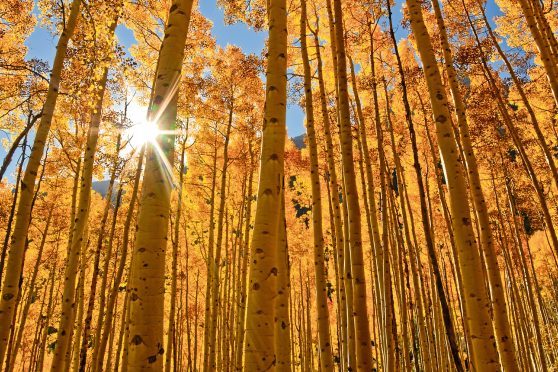Something trembled in a corner of my sight, something tiny and pale in all that pinewood landscape. A mountain burn tumbles past the corner of the wood and into the river there, and where their banks meet is a small stand of aspens.
In summer aspen leaves sizzle audibly in the lightest of breezes, in autumn they are simply the superstars of any wood, such is their bright gold capacity to outshine their neighbours. But in winter they fade into silence and anonymity.
Except that right here, right now, one of a dozen or so aspens has managed to hold on to four of its leaves on a single twig, the palest shade of gold you ever saw, and the wind is playing with them, the way winds and aspen leaves do. And it was that which trembled in a corner of my sight. So I wandered over and (as is sometimes my habit when I have nothing better to do) I made a crude sketch of the trees in a notebook, and made a note beside the drawing of the tree in question that it still had four leaves.
I wonder about aspens, for it seems they have got under the skin of some of the natives. The whispering conspiracy of its constantly restless, constantly rustling leaves has been a source of unease for a very long time.
In old Scots, the aspen is the quaking ash. In Gaelic it is critheann or critheach, from crith, meaning tremble. Its Latin classification is Populus tremula, the trembling poplar. In parts of the Borders there is a local name: “old wives’ tongues” (the leaves are tongue-shaped and they do gossip), and in Ardgour there is the mysterious sron a chrithean – trembling nose.
The implication of much of our associated folklore is that there is a sinister aspect to the restlessness of the leaves, the most durable theory being that the cross of Calvary was made of aspen wood and that is why the tree may never rest.
Now, the closest I have ever been to the Holy Land is Switzerland but I understand it to be hot, dry and dusty, and thousands of newsreel clips appear to bear that out. But the aspen tree’s extensive shallow roots send up suckers to create small thickets, a technique that requires cool, damp conditions, like the corner of this Highland wood where burn meets river.
So I doubt if the aspen ever grew in the Holy Land, and if it did, it would have been so rare that it would never have been the material of choice for a local carpenter when he was commissioned to make three crosses.
I was about to embark on a clinching piece of research on the subject of trees in the Holy Land when I discovered that just such research was already in my bookshelves, in a book called A Pleasure in Scottish Trees by retired forester Alistair Scott.
As it happens, Alistair was a friend of a friend and I met him twice, after which he sent me a copy of his privately-published book, which is an absolute delight. His research propped up my theory about the Holy Land – no aspen trees, ever.
He also observed that “aspen needs a fertile mineral soil which is one reason why you will often see it by a burnside…Frequently, it will be a clump deriving from root suckers. The individual stems are short-lived; the clump is, I suppose, immortal.”
Interesting choice of word in the circumstances, immortality being a core tenet of the religion named for the man who died on that non-aspen cross on Calvary.
Yet the tradition endures, despite the botanical evidence to suggest that it is impossible. The ancient source of the tradition is lost but its modern manifestation stems from a much-quoted passage in Alexander Carmichael’s 19th Century Carmina Gadelica: “Clods and stones and other missiles, as well as curses, are hurled at the aspen by the people of Uist because it was used to make the Cross on which Christ was crucified. No crofter or fisherman would use aspen wood for any purpose.”
The Carmina Gadelica is a collection of Gaelic hymns, poems and other utterances, many of which refer to the place of native flora in the Gaelic tradition. A hundred years after his death, scholars still disagree about how much Carmichael tampered with the fruits of his copious research.
Why Uist of all places was supposed to be so militantly anti-aspen is not explained, and Scott pointed out that the aspen grows well in the Western Isles. Maybe the islanders’ aim with the clods and stones and other missiles was indifferent, likewise the potency of the cursing.
There are many mysteries woven into the Christmas story and all that flowed from it, and some of them are more plausible than others. On the other hand, you never see fairy lights on an aspen tree.
